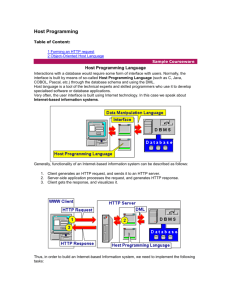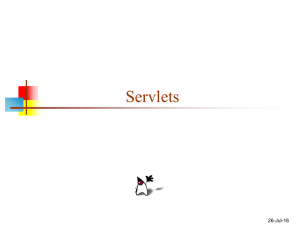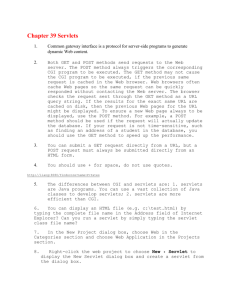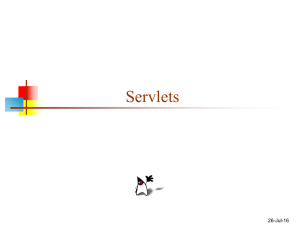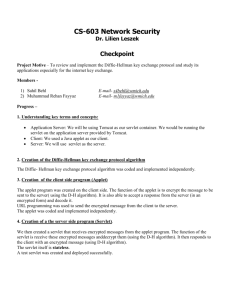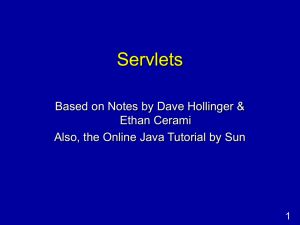servlet
advertisement
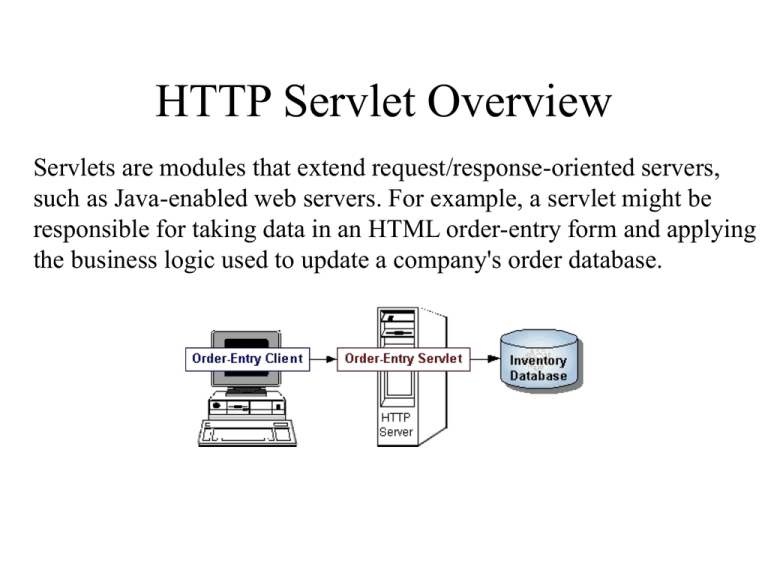
HTTP Servlet Overview
Servlets are modules that extend request/response-oriented servers,
such as Java-enabled web servers. For example, a servlet might be
responsible for taking data in an HTML order-entry form and applying
the business logic used to update a company's order database.
Java Servlets
•
•
•
•
•
Java’s answer to CGI + ASP
A little more general than CGI/ASP, etc.
Work with all major web servers
Need web server servlet engine
Need servlet development kit
What’s good about them?
• Concurrency – A servlet can handle
multiple request. (Synchronize)
• Forward Request
• Portability
• Efficiency
• Power
• Safety
Types of Servlet
• Generic Servlet
– javax.servlet (package)
– extends javax.servlet.Servlet
– service method
• Http Servlet
– javax.servlet.http (package)
– extends javax.servlet.HttpServlet
– doget(), doPost()….
Types of servlets (cont..)
• Generic servlet
– service(Request, Response) throws
ServletException, IOException
• HttpServlet
– doGet(HttpServletRequest req,
HttpServletResponse res)
Basic Servlet example
import java.io.*;
import javax.servlet.*;
import javax.servlet.http.*;
public class Test extends HttpServlet{
public void doGet(HttpServletRequest in,
HttpServletResponse out) throws
ServletException, IOException {
out.setContentType(“text/html”);
PrintWriter p = res.getWriter();
p.println(“<H1>HELLO, WORLD!</H1>”);
}
}
POST Example
import java.io.*;
import javax.servlet.*;
import javax.servlet.http.*;
public class Test extends HttpServlet{
public void doGet(HttpServletRequest req,
HttpServletResponse res) throws
ServletException, IOException {
res.setContentType(“text/html”);
PrintWriter out = res.getWriter();
String pin = req.getParameter(“to”);
String orig =
req.getParameter(“from”);
out.println(“Sending page to “ + pin
+ “ from “ + orig);
// Actually send the page.
}
public void doPost(HttpServletRequest
in, HttpServletResponse out) throws
ServletException, IOException {
doGet(in, out);
}
}
Counter example
import ….;
public class SimpleCounter extends HttpServlet {
int count =0 ;
public void doGet( …….) throws ….
{
res.setContentType(“text/plain”);
PrintWriter out = res.getWriter();
count ++;
out.println(“Hit number: “+count);
}
}// end of class
• What is the problem with the above
example??
Synchonized counter
import ….;
public class SimpleCounter extends HttpServlet {
int count =0 ;
public void doGet( …….) throws ….
{
res.setContentType(“text/plain”);
PrintWriter out = res.getWriter();
synchonize(this) {
count ++;
out.println(“Hit number: “+count);
}
}
}// end of class
Servlet Life Cycle
• Initialize using init method
• Servlet handles requests/clients
• Server removes the servlet using destroy
method
Servlets vs. Applets
• Similarities
– Neither has a main()
– Both have init() and destroy()
– Both are part of a larger application made for
the web
Servlets vs. Applets (cont..)
• Dissimilarity
– Applets run on the client (browser) while servlets run
on the HTTP server
– Applets are usually “crippled” in functionality, having
limited ability to look at the local file system, establish
network connections, etc.
– Servlets are generally built to handle multiple clients at
once, whereas applets generally service one client at a
time.
– Servlets handle HTTP request
– …
Reference
• Sun’s website http://java.sun.com/docs/books/tutorial/servlets/lifecycle/index.html

